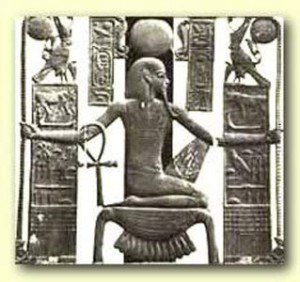The Egyptians believed that before the world was formed, there was a watery mass of dark, directionless chaos. In this chaos lived the Ogdoad of Khmunu (Hermopolis), four frog gods and four snake goddesses of chaos. These deities were Nun and Naunet (water), Amun and Amaunet (invisibility), Heh and Hauhet (infinity) and Kek and Kauket (darkness). The water stretched infinitely off in all directions, as ever lasting as time itself. Heh and Hauhet came to symbolise infinity. After the Egyptians believed that time began, Heh and Hauhet came to symbolise limitless time, and long life.

Heh
The frog or human headed god Heh (Huh) was one of the original eight gods of the Ogdoad of Khmunu (Hermopolis). He was the god of infinity and time, the god of long life and eternity. In his hand he is shown holding one or two palm fronds of ‘A Million Years’ in his hands, the Egyptian sign of long life. Sometimes he was shown wearing a palm frond on his head, as a headdress. As a god of infinity, his name was linked to numbers. His determinative, an image of Heh with his arms raised, was used for ‘one million’. It seems that ‘million’ was a number for eternity; the ‘Barque of a Million Years’ was the name of the boat that the sun god Ra travelled in during the day, which the Egyptians believed would happen until the end of time, when chaos took over the land once more. This centerpiece of a princess’ necklace is composed around the throne name of King Senusret II. It was found among the jewelry of Princess Sithathoryunet (sit-hathor-you-net) in a special niche of her underground tomb beside the pyramid of Senusret II at Lahun. Hieroglyphic signs… might be read as a text saying, “The god of the rising sun grants life and dominion over all that the sun encircles for one million one hundred thousand years [i.e., eternity] to King Khakheperre [Senwosret II].” Heh was also eight different gods – like Hathor and the seven Hathors – who were believed to support the great celestial cow in the heavens. He, like Nun, was also believed to hold up the solar barque of Ra, and to life it up into the sky at the end of its voyage through the land of the dead. Some believe that Heh was a representation of fire at one point, though it seemed that he was regarded as representing different things over time. While being a god of fire, he was shown as a snake headed god. Hauhet, as a goddess personifying fire, was shown with the head of a cat.
Hauhet
The feminine of the god Heh, Hauhet (Hehet) was a much more obscure goddess than her husband. She was a snake-headed woman who ruled over infinity with her husband. He name was the same as her husband’s, except with a feminine ending. Heh and Hauhet are rather difficult ideas to grasp, perhaps active and passive infinity would be a good expression. This infinity is mostly conceived in relation to time, and is consequently equivalent to, and often described by the Greek Aion; as infinity of form it resembles Eros … The first act of a creation is the formation of an egg, which rises upon the hands of Heh and Hauhet out of the proto-matter. Out of the egg arises the god of light, Ra, the immediate cause of life in this world. Hauhet was the feminine to Heh’s masculine, more of a representation of duality than an actual goddess, so she was even less of a deity than Heh, and more of an abstract.